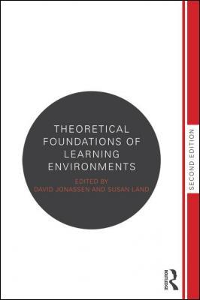Theoretical Foundations of Learning Environments

This book is a collection of essays that explore different pedagogical theories and how they affect, and are implemented in, the learning environments in schools and workplaces.
My reading notes
Part 1: Overview
Ch. 1: Student-centered learning environments: Foundations, assumptions and design (Land, S., Hannafin, M., and Oliver, K.)
Part 2: Theoretical perspectives for learning environments
Ch. 2: From practice fields to communities of practice (Barab, S., and Duffy, T.)
Ch. 3: Designing model-based learning environments to support mental models for learning (Pirnay-Dummer, P., Ifenthaler, D., and Seel, N.)
Ch. 4: Conceptual change and student-centered learning environments (Jonassen, D. and Easter, M.)
Ch. 5: Argumentation and student-centered learning environments (Nussbaum, E.)
Ch. 6: Theory and practice of case-based learning aids (Kolodner, J., Dorn, B., Thomas, J., and Guzdial, M.)
Ch. 7: Metacognition and self-regulated learning in student-centered learning environments (Azevedo, R., Behnagh, R., Duffy, M., Harley, J., and Trevors, G.)
Ch. 8: Embodied cognition and learning environment design (Black, J., Segal, A., Vitale, J., and Fadjo, C.)
Ch. 9: Everyday expertise: Learning within and across formal and informal settings (Zimmerman, H., and Bell, P.)
Ch. 10: Activity theory in the learning technologies (DeVane, B., and Squire, K.)
Ch. 11: Learning communities: Theoretical foundations for making connections (Hill, J.)
Ch. 12: What is a community of practice and how can we support it? (Hoadley, C.)
Part 3: Theoretical perspective for investigating learning
Ch. 13: Learning environments as emergent phenomena: Theoretical and methodological implications of complexity (Jacobson, M., and Kapur, M.)